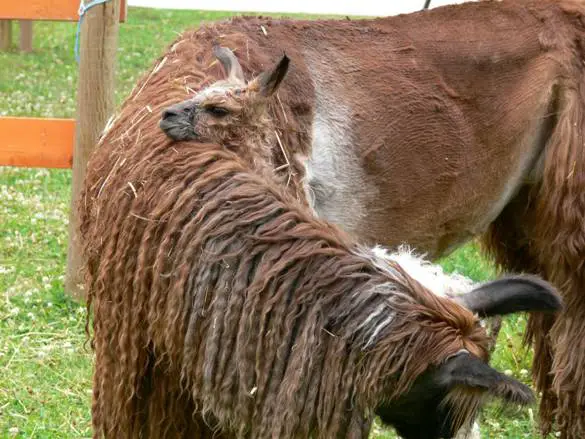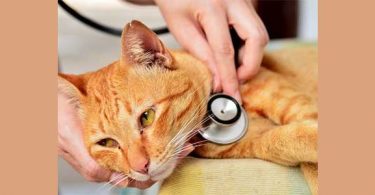With the increasing number of llamas arriving at The Llama Sanctuary, came the escalation of veterinary bills and the results seen from the use of typical pharmaceutical treatments have been far from great; in fact all too frequently, they have been devastating.
For many years, Lynne and I have used homoeopathy for treating ourselves and our pets. Living for a number of years more than three hours journey from the nearest doctor and over four hours from the nearest vet, we learned to take full responsibility for our health and alternative healing systems were studied with practical need in mind. Treating our cats with homoeopathy was a hit-and-miss affair, and the misses were more common than the hits. Treating the llamas created a whole new game. Llamas are such stoic creatures that it is common for them to be ill for many months without exhibiting any external symptoms or behavioural changes. The pivotal point arrived with one particular incident involving a baby llama with rampant infection from a sequestered necrotic bone in her leg. She had broken her leg without displaying any outward signs of pain or discomfort until the infection took hold and the leg swelled into the shoulder.
She sat on the back seat of the pickup truck for the four hour journey to the vet, where the news was presented that she had zero percent chance of survival. The veterinary college in Saskatoon offered a less than zero percent chance …whatever that might mean. In any case, it sounded like there was no hope for her. But some part of me knew that there must be another possibility. We each have lives filled with infinite possibilities; it is down to us to turn the possibilities most appropriate for us at the time, into realities.
To support my own research, I appealed for help on the Hpathy veterinary forum. Knowledgeable people generously responded to questions and the baby llama responded to the collectively selected remedies. Ping became a living testimony to the power of homoeopathy and her daily presence inspires us to this day to embrace this miracle healing system in every way possible.
Fast forwarding through a few of life’s trials and tribulations and finally, we created the opportunity to get down to serious study. At the time, The British Institute of Homoeopathy was the only organization offering distance learning for a veterinary qualification. Measured against my expectations, the two-years spent studying veterinary homoeopathy fell disappointingly short and although healing results were improving, there were still more misses than hits. Homoeopathy I discovered, turns out to be an extraordinary art form, with a methodology especially challenging to employ with animals.
I was told once that homoeopaths are like good wine, they improve with age and are not worth anything until they’ve been in the cellar for at least ten years and been turned regularly. I committed to being the best homoeopath that I could possibly be and enrolled in continuation study over the Internet, with some of the best contemporary homoeopaths.
Applying homoeopathy to animals can be extremely challenging, especially since much of the art-science is translated from the knowledge we have accumulated concerning its application to humans. Humans are quite expressive and vocal about their symptoms; animals usually can’t tell you where it hurts or what they are feeling. In most cases, the analysis lacks modalities and/or concomitant symptoms. Veterinary homoeopathy therefore, requires acute observation skills and often a considerable amount of study in order to treat each case.
Specializing in camelids has also provided significant challenges. With no camelid-specific, homoeopathic literature available, most success has come from ignoring available veterinary literature and focusing on the more traditional texts and human-based repertories. In my experience, each animal species has distinct affinities with certain remedies, or at least responds well to certain remedies.
Llamas are amazingly stoic animals and one of the greatest challenges is identifying dis-ease before it reaches the chronic stage. Most disturbances to health however, arise within the digestive and musculo-skeletal spheres, as well as the skin. Paralysis from stroke or from cerebrospinal disorder is remarkably common, yet so too are the number of recoveries. By far the most common ailment is swelling of the lower jaw, with around one-in-five animals being affected at one time or another and often recurring throughout the life of the animal. Unfortunately, the remedy that works for one may not work for another. This is obviously true throughout homoeopathy, but usually the only presenting symptom in a llama is a swelling on the lower jaw; no expression of pain, no modalities, no temporal or thermal hooks upon which to hang the case and no concomitants. It continued to be a hit-and-miss game, only with a greater understanding of which remedies might work.
If there is one way to impress upon someone the power of the H-pill, it is through working with babies. Babies of any species often respond rapidly to the well-prescribed remedy. On two occasions we have held a dying baby llama or cria, in our arms and within seconds of administering a few drops of Belladonna or Nux Vomica, the limp bundle sprang back to life and vigorously wrestled to free itself from our grip. Even in older animals, the sooner the remedy is administered following onset of the disease, the faster and more complete the recovery turns out to be. In several cases of paralysis following a stroke, the llama has made a complete recovery in just a few days.
These are the joy-filled rewards for devoting our lives to protecting animals. More often the days are spent on the more mundane aspects, like caring for the pastures and buildings, repairing fences, shovelling manure and raising funds in order to continue the rescue work.
The Llama Sanctuary is dedicated to the rescue, rehabilitation and rehoming of camelids in need. It involves catching llamas that have been released into the Canadian wilderness or left to fend for themselves on properties abandoned due to foreclosure. It is often the realtor who calls The Llama Sanctuary after discovering a llama roaming the yard or sitting matted and dejected in a field. Sanctuary assistance is sometimes called for when the keepers die. Many times, The Llama Sanctuary simply acts as the connector between llamas looking for homes and homes looking for llamas.
Llamas and alpacas appear to be especially sensitive to pharmaceutical drugs and most veterinarians treat them as if they were horses or cows, administering massive doses of antibiotics that can wipe out the animals natural defences and digestive flora. It may be that the more commonly found animals have become inured to the chemical onslaught, but anyone who has spent time with llamas will appreciate how acute their senses can be, especially their sense of smell. The fact that they use spitting as a weapon provides adequate testimony to their sense of smell, for the odour of the spit acts like a stun grenade, incapacitating both their opponent and themselves for around fifteen minutes! Numbing their senses or disrupting the finely tuned sensory mechanism appears to have a knock-on effect throughout the digestive system. Even a slight change in diet or weather can cause diarrhea.
One thing that I have learned and continue to learn from employing homoeopathy is patience and I am fully aware that my biggest fault is still a desire to do something other than watch and wait. I shall have a batch of T-shirts printed with ‘Homoeopath at Work – Your Patience is Appreciated’.
Communicating with other homoeopaths helps me to understand that my learning curve has adhered to the pattern typical of most wannabee homoeopaths: missing or misinterpreting the key symptoms, changing the remedy too soon, spending more time concerning myself with the matter of potency rather than the suitability of the remedy and constantly looking for shortcuts or a mechanical method of remedy selection.
There are no shortcuts; the right remedy will work in any potency and nothing can substitute for experience and time in honing one’s skill in the homoeopathic art.
The Llama Sanctuary
2368 Enderby Mabel Lake Road
Enderby, British Columbia, V0E 1V5
Tel: +1 250 838 7043
Email: [email protected]
Web: www.llamasintheraw.com








This account of David Chapman and Lynne Milsom caring for Llamas in British Columbia warmed my heart. They truly found their “higher calling” in life. It is heartening to learn that in a world of great indifference and cruelty there are people who can open their hearts to helpless animals. That fact that they use a holisitc approach to healing is ever more extraordinary.